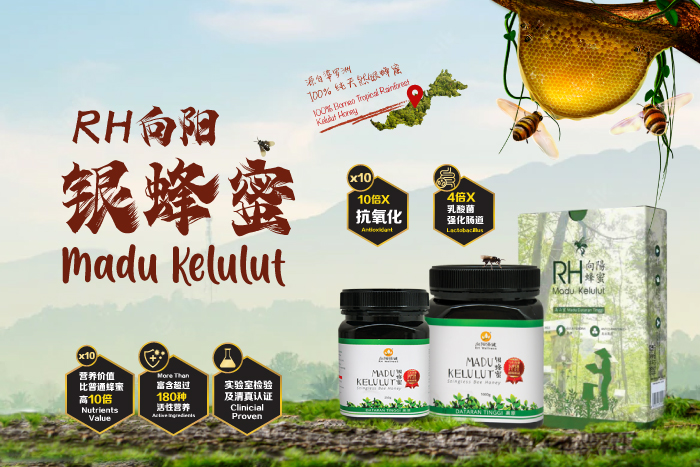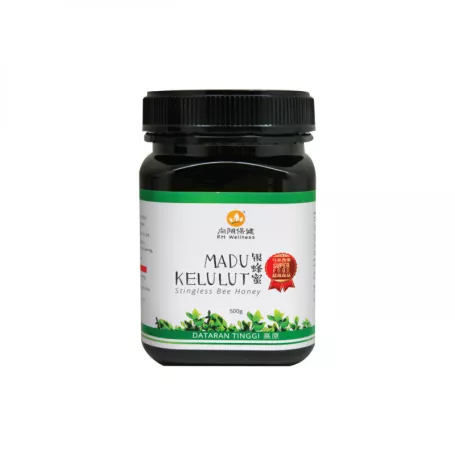How to Differentiate Between Kelulut Honey and Regular Honey

Honey is a natural product with centuries of use in food and medicine. Known for its antibacterial and antioxidant properties, honey has earned a place in the diets of many health-conscious individuals worldwide. However, not all honey is created equal, and different types of honey vary significantly in their production, properties, and benefits. Among the many types of honey, Kelulut honey, derived from stingless bees, has recently gained attention for its potent health benefits and unique qualities.
In this article, we'll explore the differences between Kelulut honey and regular honey, how to identify Kelulut honey, and why it might be worth adding to your diet. We'll also look at the benefits, applications, and key points to consider when choosing high-quality Kelulut honey.
What is Kelulut Honey?
Kelulut honey, also known as stingless bee honey, comes from a species of stingless bee called Trigona or Meliponini. These bees are smaller than regular honeybees and are native to tropical and subtropical regions, including Southeast Asia, particularly in Malaysia, Thailand, and Indonesia.
Unlike regular honeybees, stingless bees store their honey in small resin pots instead of honeycombs. Kelulut honey has a tangier and more acidic flavor, with a slightly thinner consistency compared to regular honey. It is also rich in nutrients such as flavonoids, phenolic acids, and other bioactive compounds that provide numerous health benefits.
Kelulut honey is produced in smaller quantities than regular honey, making it rarer and often more expensive. The stingless bees' complex fermentation process adds to the honey’s unique composition, making it particularly rich in medicinal properties.
What is Regular Honey?
Regular honey comes from the honeybee species Apis Mellifera, which are found in many parts of the world. Honeybees produce honey by collecting nectar from flowers, which is then processed, stored in wax honeycombs, and used to feed their colonies.
Regular honey is widely available and varies in flavor, color, and texture depending on the flowers from which the nectar is collected. While regular honey is still highly nutritious and valued for its antimicrobial and antioxidant properties, its nutrient content can vary based on the processing methods used. Many commercially available types of honey are pasteurized and may be diluted or mixed with other sugars, reducing their overall nutritional value.
Key Differences Between Kelulut Honey and Regular Honey
Though both types of honey are beneficial, they have significant differences in composition, taste, and health benefits. Here are some key differences:
| Feature | Kelulut Honey | Regular Honey |
|---|---|---|
| Bee Species | Stingless bee (Trigona/Meliponini) | Honeybee (Apis Mellifera) |
| Production Method | Stored in resin pots, more complex fermentation | Stored in wax honeycombs, traditional method |
| Flavor | Tangy, acidic, slightly sour | Sweet, floral, mild |
| Consistency | Thinner, more watery | Thicker, more viscous |
| Nutrient Content | High in flavonoids, phenolic acids, antioxidants | Varies depending on processing |
| Yield | Lower, more expensive | Higher yield, widely available |
| Fermentation Process | Naturally fermented, enhancing bioactivity | Minimal fermentation |
How to Identify Kelulut Honey
To ensure you're getting authentic Kelulut honey, it's essential to know what characteristics to look for. Here are a few tips:
-
Consistency: Kelulut honey is naturally more watery compared to regular honey. It flows easily and doesn't crystallize as quickly.
-
Taste: Kelulut honey has a distinct tangy or slightly sour flavor, with a mild sweetness. This unique taste differentiates it from the typical sugary flavor of regular honey.
-
Color: Authentic Kelulut honey can range from light yellow to dark brown, depending on the plants the bees foraged from.
-
Source: Always purchase Kelulut honey from reputable suppliers. Look for certifications like Halal, MeSTI, GMP, and HACCP to ensure quality and safety.
-
Price: Kelulut honey is generally more expensive due to its lower production yield and rich nutrient profile. Be wary of suspiciously cheap Kelulut honey, as it could be adulterated.
Benefits of Kelulut Honey vs. Regular Honey
Both Kelulut and regular honey offer various health benefits, but Kelulut honey has a more concentrated nutrient profile due to its unique production process. Here's a comparison of the benefits:
Kelulut Honey:
- High in Antioxidants: Contains more flavonoids and phenolic acids, which help neutralize free radicals and reduce oxidative stress.
- Immune Boosting: Enhances the body's immune system, helping to ward off infections and diseases.
- Anti-inflammatory Properties: Kelulut honey is excellent for reducing inflammation, making it helpful for managing conditions like arthritis.
- Improved Digestion: Promotes gut health by supporting beneficial gut bacteria and aiding in the treatment of digestive issues.
- Wound Healing: Its antibacterial and anti-inflammatory properties accelerate the healing of wounds, burns, and ulcers.
Regular Honey:
- Energy Source: Regular honey provides a quick source of energy due to its natural sugars (fructose and glucose).
- Antibacterial: Like Kelulut honey, regular honey can help fight infections and promote healing due to its antibacterial properties.
- Cough Suppressant: Regular honey is often used to soothe sore throats and reduce coughing.
- Rich in Enzymes: Raw honey is rich in enzymes that aid digestion and nutrient absorption.
Usage and Applications
Kelulut Honey
Kelulut honey is versatile and can be used in various ways:
- As a Health Supplement: Take a teaspoon of Kelulut honey daily to boost immunity and enhance overall health.
- For Wound Care: Apply directly to minor wounds, burns, or ulcers for faster healing.
- In Drinks: Add to warm water, tea, or smoothies for a refreshing and health-boosting drink.
- In Skincare: Mix with natural ingredients like turmeric or yogurt for homemade face masks to promote healthy, glowing skin.
Regular Honey
Regular honey is more commonly used in:
- Baking and Cooking: As a natural sweetener in cakes, bread, and sauces.
- Drinks: Added to teas or coffee as a sugar alternative.
- Cough Remedies: Combined with ginger or lemon to soothe sore throats and reduce coughing.
- Topical Treatments: Used for minor burns, cuts, and scrapes due to its antibacterial properties.
RH Wellness Stingless Bee Honey: Premium Immune Booster with Natural Antioxidants and Healing Properties
For those looking for high-quality stingless bee honey, RH Wellness Stingless Bee Honey stands out as a premium product. Sourced from the pristine highlands of Borneo, Malaysia, this honey offers superior health benefits compared to regular honey.
Key Benefits:
- Boosts Immunity: Enhances the body's natural defenses, helping to prevent illnesses.
- Antibacterial and Anti-inflammatory: Soothes coughs, sore throats, and mouth ulcers, providing relief from common ailments.
- Promotes Healing: Accelerates wound healing and supports cell regeneration.
- Energy Enhancer: Increases energy and stamina, making it ideal for pre- and post-exercise use.
Product Features:
- 100% Pure and Natural: Free from artificial additives and pesticides.
- Sourced from Borneo: Harvested from the highlands of Borneo, Malaysia, ensuring a premium product.
- Certified Quality: Packaged in food-grade PET plastic jars, with certifications from MeSTI, Halal, GMP, and HACCP, guaranteeing safety and quality.
Usage Recommendations:
- Take 1-2 teaspoons daily for immune support.
- Apply topically for minor wounds or skin irritations.
- Mix with warm water or tea for a health-boosting drink.
5 FAQs
1. What are the main differences between Kelulut honey and regular honey?
The main differences lie in their bee species, production methods, taste, and nutrient content. Kelulut honey is more tangy, contains more antioxidants, and is produced in smaller quantities, making it rarer and more expensive than regular honey.
2. How can I identify authentic Kelulut honey?
Authentic Kelulut honey is thinner in consistency, has a tangy taste, and is often more expensive. Always purchase from reputable suppliers and look for certifications.
3. What are the health benefits of Kelulut honey compared to regular honey?
Kelulut honey offers higher levels of antioxidants and anti-inflammatory properties, making it more beneficial for boosting the immune system, promoting wound healing, and improving digestion.
4. How should Kelulut honey be used in comparison to regular honey?
Kelulut honey can be used similarly to regular honey, but it is often taken as a health supplement due to its potent medicinal properties. It can be added to drinks, used for wound care, or applied to the skin for its anti-inflammatory benefits.
5. Are there any specific characteristics to look for in high-quality Kelulut honey?
Look for a watery consistency, tangy flavor, and reputable certifications like Halal, MeSTI, or HACCP. High-quality Kelulut honey is often sourced from tropical regions like Malaysia and should be free from additives or contaminants.
Conclusion
While both Kelulut honey and regular honey have their merits, Kelulut honey stands out for its higher nutrient content, unique flavor, and more potent health benefits. Whether you're looking to boost your immune system, improve digestion, or enhance your energy levels, Kelulut honey is a valuable addition to your daily diet. When choosing Kelulut honey, always ensure that you're buying from reliable suppliers to get the best quality product. With its distinct properties and numerous health benefits, Kelulut honey is a true powerhouse of nature.

 Bahasa melayu
Bahasa melayu 中文
中文

























